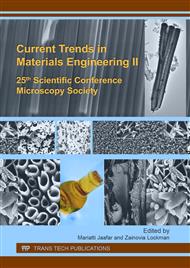p.128
p.132
p.136
p.140
p.144
p.148
p.152
p.156
p.160
The Morphology and Mechanical Study on Neolamarckia cadamba and Endospermum diadenum in Wood Composite for Particleboard Application
Abstract:
This research was carried out to investigate the morphology of particleboard by using lesser-known commercial timbers (LKCT) species which are well-known in scientific name as neolamarckia cadamba (NC) and endospermum diadenum (ED). NC and ED are fast growing species available in Peninsular Malaysia. Single layer particleboard was fabricated from urea formaldehyde (UF) blended with NC and ED at different species ratio. The morphological observation on particleboard was conducted using field emission scanning electron microscopy. Particleboard boards with different resin content and species ratio. The results indicated that 7:3 of NC: ED with ratio at 12% of UF have a significant effect in term of surface morphology compared to 1:0 of NC: ED. This can be proved through mechanical and physical properties testing where NC: ED particleboard panel with 7:3 ratio exhibit the highest strength according to EN standard. NC particles can be used as a raw materials to wood-based particleboard for general purpose application.
Info:
Periodical:
Pages:
144-147
Citation:
Online since:
September 2017
Authors:
Price:
Сopyright:
© 2017 Trans Tech Publications Ltd. All Rights Reserved
Share:
Citation:


